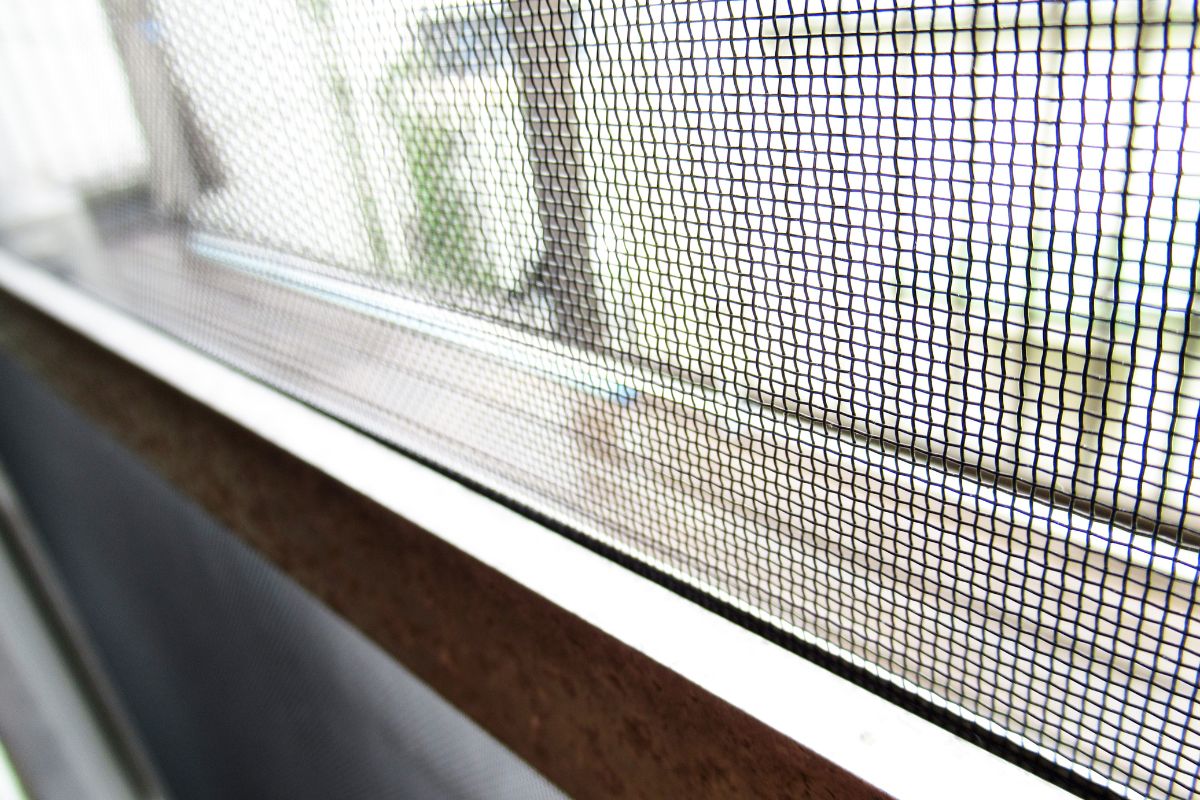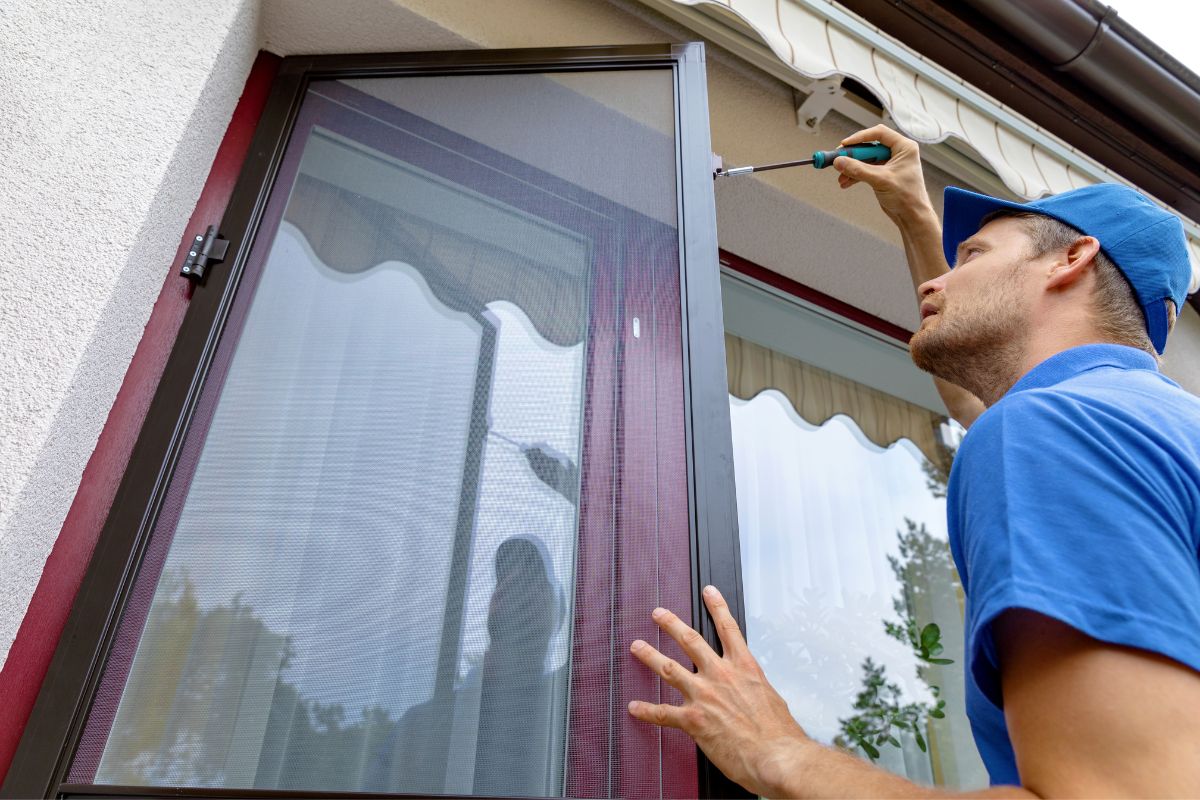A screen door allows you to enjoy the outdoors without inviting all the bugs that live outside into your home.

If you want a nice cool breeze in the warm weather but don’t want to be invaded by insects you should know how to install a screen door.
Measure Your Existing Door Frame
The first thing you need to do is measure the existing door frame. For this you will need to take six measurements.
Measure the width of the frame at the top, middle and bottom and then measure the height at the left, center and right of the door frame.
You do this because not all door frames are perfectly square which means they are not precisely the same width all the way down or the same height all the way across. There may be small discrepancies.
An average external door is 80 inches high and either 30, 32 or 36 inches wide. These are some standard widths, but there are other sizes.
Now you need to subtract ¼ inch from the shortest width and length measurements. This is because you need ⅛ inch gap around the entire door to ensure it will fit properly.
Using the shortest length and width means that you have compensated for the frame not being square.
Choose Your Screen Door
The choice of screen door is completely dependent on personal preference. Many people choose a style that compliments their house while others prefer the most practical option.
You can choose between wood, vinyl or aluminum screen doors. If you choose an unfinished wooden screen door you can paint it to match your home, but wood requires regular maintenance.
Vinyl and aluminum are low maintenance but may only be available in limited color ranges.
The most important thing is that the screen door is the right size.
You will also need to decide which type of mesh you want. The choices are plastic, flexible metal or solid metal.
Checking The Fit Of The Screen Door
Decide which way the door will open. The screen door would normally open at the same side as your main door.
However, if it comes with a preinstalled handle which may collide with the main door’s handle you can have it open from the opposite side.
Wedge the screen door in place with shims and make sure that it fits. Use at least one shim on the top and bottom and two on the sides.
This will ensure that there is a ⅛ inch gap all around the edge of the screen door.
If a shim can’t be inserted it means the screen door is too big. Mark the area that needs to be removed and use a circular saw to trim it down.
For vinyl or aluminum doors you may need a professional to trim the door down for you.
Fitting Hinges
Measure the door for the placement of the hinges, there may be two or three. These will be on the opposite side of the door to the handle.
The top and bottom hinges should be at least 5 inches from the top and bottom of the door.
If there is a third hinge this needs to be placed centrally between the top and bottom hinges.
Alternatively you could fix the hinges to the screen door to match the position of the hinges on the main door.
This eliminates the need to measure for the hinges.
Mark the position of the hinges on the door with a pencil or marker as well as the location of the screw holes.
Use a drill to make pilot holes for the screws. The drill bit should be smaller than the screws.
Use a drill with screwdriver attachment to screw the hinges to the door. The hinge should be pressed firmly against the door so that it is secure.
There will normally be three screws per hinge. Secure the middle one first and then the other two.
Only use the hinges and screws that came with the door as these will be the most appropriate for it.
Install The Screen Door

You can now fit the screen door to the door frame. With the door held in place, start drilling the pilot holes for the hinge screws.
Use a drill bit that is slightly smaller than the screws.
Then line up the hinges with the drilled screw holes and attach them to the door frame, using a drill with a screwdriver attachment.
Although you will have the door spaced with shims and the hinges mounted you may still want to check that the door is level before tightening the screws completely.
Once the door is hung check that it is swinging freely on its hinges and that no other adjustments are needed.
If the hinges are not tightly fitted the door may sag slightly and not close properly. Make sure that the screws in all the hinges are securely tightened.
Install Handle & Latch
Some screen doors come with pre-fitted handles while others need to be installed by you.
Check the best location for your handle and that it doesn’t collide with the main door handle when in use. If this is the case consider raising the handle on your screen door a bit higher.
Once you have chosen a position for the handle, mark the screw holes with a pencil or marker and drill some pilot holes for the screws. Now insert the screws and tighten into place with the help of a powered screwdriver or drill.
You may want a latch on the screen door to stop it banging in the wind. Fit the latch that came with the door or buy a simple hook and latch.
Final Thoughts
A screen door is a great bonus in the summer. It will prevent bugs coming into your house but allow you to enjoy a nice cooling breeze and fresh air.
We hope this guide on how to install a screen door has been helpful.
- How To Drill Into Brick? - October 31, 2022
- How To Repair And Refinish Hardwood? - October 31, 2022
- Floetrol – What Is It? When To Use It: Complete Guide - October 31, 2022
